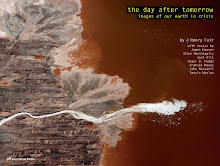A journalist, in theory, wants the facts; an artist, the essence.
I consider myself the latter.
While studying satellite imagery from the Gulf of Mexico, SkyTruth spotted an apparent slick from an oil platform and cross referenced the location to MMS info which showed it to be platform 23051 at 28.938022 - 88.970963. SkyTruth, knowing I was in the area shooting the BP Deepwater Horizon (Macondo well), asked me to investigate the location. SouthWings pilot Tom Hutchings agreed to fly by this site after our planned overflight of Macondo.
Upon navigation to the coordinates, a rig was spotted with an apparent petroleum slick on the ocean surface that extended beyond the limits of vision, and the assumption was made that this was the site in question. Next to the rig was a large boat with wake on both sides (as opposed to from the stern), but not moving. On the deck of the boat, men stood next to 9 barrels and a hose which hung over the port side of the boat. There was a yellow buoy or other flotation device where the hose entered the water. Several circles were made around the site, during which time the boat still did not move. Close-up photos show the name of the rig to be “Diamond Offshore Ocean Saratoga,” and the boat, the “Ram Charger.”Further examination of the photos shows in the distance an object with what appears to be another long slick, and comparison hand-held GPS coordinates taken from the plane are in a different location than the original coordinates given by SkyTruth. Thus, there are two leaks.
Taylor Energy (now owned by a Korean holding company) holds the lease on the well and states that they are:
“renting a rig from Diamond Offshore Drilling Inc. to plug wells that were destroyed by an undersea mudslide during Hurricane Ivan in 2004.” (Quoted from Reuters)
and:
"As a result of deploying three subsurface containment domes and performing six successful well interventions, the initial average observed sheen volume of nine gallons per day has been substantially reduced."
The leak we see in the photos appears to be much greater than “nine gallons per day.”
Taylor said:
“the photos had incorrectly identified a leak coming from the Saratoga, whereas at that time the company had actually been operating a 180-foot dynamically positioned workboat for a scheduled containment system drainage.”
But curiously, in the next paragraph we read:
“Gary Krenek, Diamond's chief financial officer, had said earlier that while his company was required to report spills off its rig, and had not done so, it was contractually unable to discuss anything further.”
He referred questions to Taylor.
So they broke the law and can’t discuss it?
The official story does not jibe with the observed facts.
Meanwhile, after we announced the spill, the share price of Diamond Offshore dropped sharply. Alas, I am neither clever nor stupid enough to short a stock prior to releasing my photos, and I spent a day dodging calls from media and hedge fund operators. The fixation on quarterly earnings, and the gyrations and machinations of the stock market place our society in great peril on many levels.
Rather that fixating on the possibility of a well leak in regards to what it might mean to the stock price of a company, we would do better to fixate on what it means to the dolphins and the turtles, and our grandchildren.
According to a reporter from the Mobile Times Register, there are 600 unexplained leaks per month in the Gulf. The Diamond Offshore occurrence(s?) may or may not be a leak. The BP Deepwater Horizon may or may not be the largest spill in the Gulf this year. There will be many, and at some point, the culmination will overwhelm the flora and fauna that have teetered back from the brink so many times before. Then we will have systemic failure, and the Gulf becomes a dead sea, the consequences of which exceed comprehension. Just the litigation around the impacts of this one instance is incomprehensible.
The Conservatives decry the Liberals for forcing the oil companies to drill offshore rather than get the easy oil in Alaska. But the fact remains that resources are limited by definition, and our increasing hunger for oil will drive acquisition to the darkest corners of the planet. To get there, we will push the limits of technology, which means more accidents…







